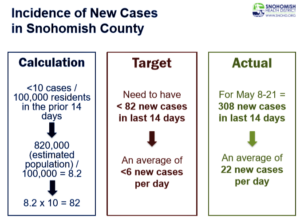Today as part of a regular briefing on the COVID-19 Pandemic, Snohomish Health Officer Dr. Chris Spitters outlined where Snohomish County stands on moving to Phase 2 of the State’s four-phase plan to getting back to normal. The news was not positive for moving forward anytime soon. Here’s an excerpt of the briefing.

To move to Phase 2 we need to have less than 6 new cases per day and right now we are averaging 22 per day.
So the, the metric, the criteria for passing the starting line, if you will, on phase two there is for the community to have fewer than 10 cases cumulatively in a 14 day period for every hundred thousand people. And also, this is the second criterion is not one that we monitor or do, it’s a complex calculation. It’s based on modeling. And these are the things that you’ve been seeing coming out the Institute for Health Metrics and Evaluation and the Institute for Disease Modeling. They are not currently tracking this reproductive rate for Snohomish County specifically. We know last time they did it a couple of weeks ago for Western Washington it was approaching one but slightly below it. So we’ll really be focusing on that case reporting figure.
On that case reporting figure, just to go through the math quickly. So if we’re, basically, our goal is to get under 10 cases per hundred thousand in the prior 14 days. That’s a running thing. So, you know, every day we’ll be looking back 14 days.
How many cases did we have in the last 14 days? So the goal is 82. How do we get to that? Well, 10 cases per hundred thousand in that 14 day period. We’ve got 820,000 residents. So that means 8.2 times 100,000. So that means we would have 8.2 times 10 cases as a as an allowance for the number of cases.
So 82 cases per 14 days, 82 divided by 14 is an average of about, it’s 5.8 cases per day. So six cases per day. But it doesn’t have to be exactly six cases per day. What we’re really looking for is to get that 80 or less cases in a two week period.
And just to give you an idea of where we’re at, the last 14 days we had 308 new cases report. So we’re about three and a half times above where we need to be. And so as you can see, while we’ve made significant progress in flattening the curve and seeing the number of cases decline, and even in the past week or two we’re down to, you know, maybe in the high teens, 15 to 20 cases per day over the course of the week, whereas we were at 25 to 30 two to three weeks ago. So things continue to get better, but we’re still not there. And consequently, I just, I don’t see us passing that line of 80 cases per 14 day period by the time we reach June 1.
I’d like to be more, have better news than that. I do think it’s not far off, but it’s something that’s going to take efforts by us on the containment and efforts by the community to do what they can to suppress transmission going forward and set us up hopefully to submit an application for variance sometime in the month of June.
So going forward, and getting back to what we can all do to help get us to that point down from 300 cases per two weeks down to less than 80, is remembering the science behind that reproductive rate. And again, the idea is to reduce our number of contacts, to take actions that are necessary to reduce the risk of transmission in the event we do come in contact with people. Because the other factor that affects transmission in the community, the duration of infectiousness, we have little control over.
So again, if you focus in on that left box. Our job is the isolation and quarantine, everybody’s job is to try to stay home, limit your excursions out of the home except for essential or approved work activity and necessary errands and such, healthcare, bank, you know, what have you. And try to otherwise limit our excursions out of the home. And then when we are out, try to wear a cloth face covering, especially when we will be indoors in public or commercial places, or when we’re out of doors and can’t guarantee that we’ll be able to maintain that six foot physical buffer from other people.
Frequent hand hygiene. Wash your hands when you get back home. Always hand hygiene before and after you enter
places, when you get back in the car from the grocery, when you get back home, after you put the groceries away, cleaning up again. And then cleaning all high touch services in your home or workplace frequently.




May 22, 2020
Everett